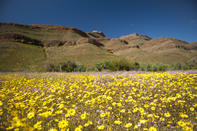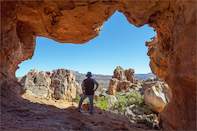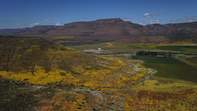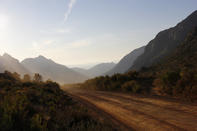Visual Drama of the Cederberg
From Nieuwoudtville, you will leave the Northern Cape and Namaqualand to enter the province of the Western Cape. Here, the displays of flowering succulents and annuals are supplemented by the restios, reeds, ericas and proteas that characterise the Fynbos Biome.

This latter vegetation type can be roughly divided into the dune fields of the Strandveld along the west coast, the endangered Renosterveld of the Swartland around Darling and the mountain Fynbos of the Cederberg. We’ll start with the unsurpassed visual drama of the Cederberg. To enter this mountainous wonderland from the Bokkeveld plateau, you can drive to Vanrhynsdorp and pick up the N7 highway to the town of Clanwilliam – the gateway to the Cederberg.
This route is about 130 km. Alternatively, you can drive south from Nieuwoudtville on the gravel R364 over the lovely Botterkloof Pass to gain direct access into the sandstone fastness of these amazing mountains. This road eventually reaches the town of Clanwilliam after 150 km, and you’ll find the turn-off to the flower-rich Biedouw Valley en route.
Highlights of the Cederberg

The weird, wind-blown rock formations of the Cederberg are beautiful in any season. Nature lovers will be entranced and could spend many days hiking through the cliffs, swimming in the rivers or exploring the exhilarating landscape in a 4x4. The birding is excellent, the campsites are stunning and there is even a winery, the highest in South Africa, for your viticultural delight.
Stargazers may also want to check out the privately owned Cederberg Astronomical Observatory. Other highlights include the Wolfberg Cracks and Arch, the Maltese Cross, the Stadsaal Caves, the bushman paintings, and jumping off the precipitous rocks into the deep river at Malgat. Unfortunately, in previous decades, much of the land in this wilderness region was degraded by unsustainable farming practices.
The indigenous Clanwilliam Cedar tree, which gives the mountains their name, was particularly hard hit and is currently a threatened species. Thankfully, these unique uplands are now under the protection of the Cederberg Conservancy, a collaborative organisation that is working with private landowners and Cape Nature to protect and restore the Cederberg’s natural splendour.
Flowers of Biedouw Valley

In terms of flowers, the most reliable place to see them bloom is in the Biedouw Valley, close to the picturesque mission station of Wupperthal. But do note that a hot berg wind could wither this colony within a couple of days, so try to check ahead before you go. Even though it generally blooms in the summer months, the rare Snow Protea "Protea cryophila" is also worth a brief mention.
This narrowly endemic plant is found only along the snow line of the Cederberg in a small belt of about 25 km in length. It grows in the cracks between bare rocks and can survive in extreme cold and blistering heat, sometimes living for up to 70 years. The white, furry flowers take a full year to open and spotting one of these floral gems is a mega-tick for flower spotters.
Jaw-Dropping Pakhuis Pass

If you are coming from the N7, the Biedouw Valley can be accessed from the town of Clanwilliam by taking the gravel R364 over the jaw-dropping Pakhuis Pass. After about 40 km on this road, you’ll see a turn-off to the right marked for Wupperthal and the Biedouw Valley. About 13 km after this, you’ll reach an intersection.
17 km to your right is the white-washed Rhenish Mission Station of Wupperthal, which has changed little since it was established in 1830. To your left is the Biedouw Valley route, which extends for about 30 km up to the little settlement of Uitspankraal. You will then have to retrace your steps to Clanwilliam or continue northwards to the R355, which leads up to Calvinia, an additional distance of 100 km from Uitspankraal.
By David Fleminger The Cederberg is named for the forests of Clanwilliam cedar trees that were all but exterminated two centuries ago for their fine timber. To...
The Cederberg is named for the forests of Clanwilliam cedar trees that were all but exterminated two centuries ago for their fine timber. To... The West Coast is an easy drive from Cape Town and the Winelands, and all you need do is head onto the N7. Villages such as Paternoster, Lan...
The West Coast is an easy drive from Cape Town and the Winelands, and all you need do is head onto the N7. Villages such as Paternoster, Lan...